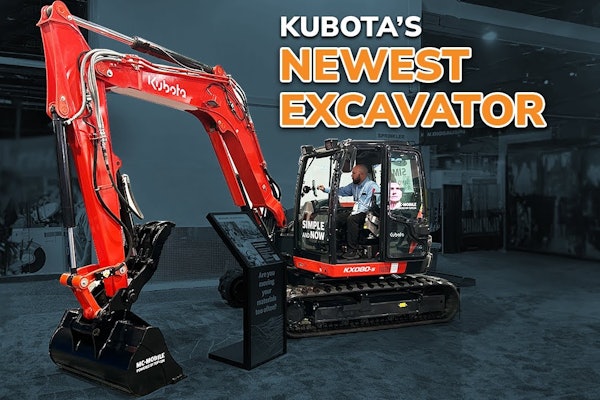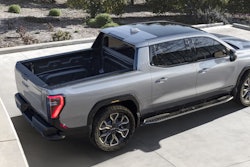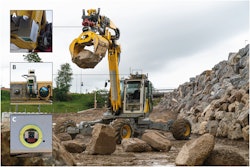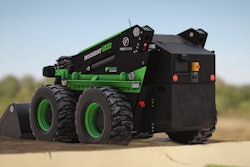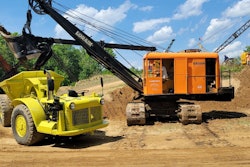They look like skid-steer loaders in work boots but they tread lightly where skid-steer loaders fear to go.
Compact rubber track loaders offer many of the same functions as their next-of-kin skid-steer loaders and are willing to work year ’round if you let them. Wide rubber tracks give these loaders better traction on soggy and slick terrain, and let you work where conditions are too spongy for wheeled vehicles.
Contractors working on established turf find the compact track loader leaves almost no trail and creates less compaction and residual surface damage than a wheeled skid-steer loader. In fact, when an operator climbs out of his loader, he will exert more ground pressure than many compact track loaders that ‘float’ at between 2.5 to 5 psi.
Brad Lemke, product expert at ASV, reminds contractors to use the right size machine for the job. “Just because the compact track loader has tracks doesn’t mean it’s a bulldozer,” he says. Lemke suggests choosing a larger machine if you are questioning what size loader to use on your job.
Jim Hughes, marketing manager for Case Construction Equipment, says contractors using track loaders in the Midwest and Northeast can begin work before winter winds down, getting an early start on the construction season in spite of jobsites with unstable wet ground, mud and snow melt. While your skid steer stands idle, your track loader will buy you early productivity – and work.
Keeping track
Rubber track loaders are designed for easy operation and maintenance but that doesn’t mean they will take unlimited abuse.
Follow these tips for increased productivity and maximum track life:
- While you won’t get a flat tire on a track loader, you can seriously damage the steel cords in rubber tracks by running them on pavement or over sharp debris. Kelly Moore, product manager at Gehl, says replacing one rubber track can cost about $2,200 dollars, so it’s important to match the job application to the machine. Avoid sites doing demolition cleanup, rocky terrain, logging stumps and extended use on concrete or asphalt.
- Many compact track loaders have audible alarms alerting you if the machine is overloaded. “Overloading is asking for trouble,” Moore says. “If the operator overloads the machine and ignores the sensor alert, the resulting damage will not be warrantable.”
- Salt or oil can contaminate and corrode rubber tracks. If exposing tracks to corrosive materials is an unavoidable part of the job, clean the exposed tracks and undercarriage immediately to prevent unnecessary deterioration.
- When working in freezing temperatures, frequently check tracks and rollers for frozen sludge and gravel debris. Neglecting to clean out icy rubble can cause excessive track and roller wear. In some cases, hardened clay can lead to detracking. Be sure to clean the track and undercarriage at the end of the day so lower evening temperatures don’t freeze drive components overnight. If moisture gets into the rubber track through a cut or gouge it can cause the embedded steel cords to corrode and break.
- The normal operating temperature range for rubber tracks is between minus 13 degrees and 130 degrees Fahrenheit. When working in extreme temperatures reduce your speed. Minimize the track’s exposure to the sun in high temperatures. Excessive heat will cause rubber to expand and crack, shortening the life of the track.
- Embedded metals adhere between the track’s steel cords and the rubber body. If your machine is used for heavy dozing or under sandy or salty conditions check the abrasion levels of the track’s embedded metal parts. Replace the track when the width of the embedded metals is less than 67 percent of its original width.
- To avoid drive component wear, always drive up or down a slope instead of crossways. Always travel with both tracks on a level surface.
- Rubber tracks generally do not have any special reinforcement. Don’t rub the sides of the rubber tracks against concrete curbs or walls because cuts or tears on the roller bar side of the track can occur. Uneven wear on the track sides can lead to detracking.
- When working in a brush cutting application changing filters is important, Lemke says. Flying debris will clog and interfere with the loader’s productivity.
- Check and adjust track tension regularly. If the sprockets are out of alignment they can pull the embedded metals and cause the track to separate and require immediate replacement.
- Do a daily visual check to look for cracks or tears on the rubber surface. Fatigue cracks are sometimes found on the lug side of the rubber track and will gradually deteriorate with even small injuries. If the track needs to be replaced, Bobcat recommends changing the drive sprockets at the same time.
- Lug abrasion is inevitable. According to Global Track Warehouse (www.gtw.com.au), when the lug heights are less than 5 millimeters or 1⁄5 inch it is time to replace the track. Minimize lug abrasion by avoiding quick and repeated turns on pavement and reducing turns made on paths covered in rock and wood.
- Avoid ozone cracks by storing your machine away from direct sunlight and in a well ventilated area. If possible, use the machine at least once a month to retain flexibility.
- Make sure any work attachments are sized correctly for your machine. Check how much hydraulic horsepower is available for the attachment and only use attachments that weigh less than the machine’s rated operating load capacity.
- If you use a ramp to load your machine onto your truck, make sure the cross member ramp supports are spaced far enough apart to eliminate catching or pinching the tracks.
Joel Powell, product specialist group manager at Volvo, has the most important and frequent manufacturer’s request for compact rubber track loader owner-operators. “Please, read the owner’s manual!” Powell says. “Daily maintenance checks and using the right loader for the right applications will keep you moving more material faster.”
Sources
Tom Tamlyn, loader product specialist, Bobcat
Brad Lemke, product expert, ASV
Joel Powell, product specialist group manager, Volvo
Jim Hughes, marketing manager, Case Construction Equipment
Kelly Moore, product manager, Gehl
Global Track Warehouse, www.gtw.com.au
Bridgestone Rubber Tracks – Types of damage during operations www.bridgestonerubbertrack.com
